Adventurous Kate contains affiliate links. If you make a purchase through these links, I will earn a commission at no extra cost to you. Thanks!
Santiago, the capital city of Chile and the gateway to all this fabulous country has to offer, will take your breath away as your plane swoops over the Andes mountains.
Santiago doesn’t get a lot of love from travelers in South America — but if you’re looking to explore this city, you’ve got plenty of options!
Planning your trip to Santiago last minute?
🏔️ Top Experiences and Tours in Santiago:
- Cable car to Cerro San Cristobal (A must — book in advance!)
- Walking tour (See all the popular sites)
- Visit Valparaiso and Viňa del Mar (Best day trip from Santiago!)
🛌 Top-Rated Hotels in Santiago:
- Hotel Casa Real – Viña Santa Rita (Luxury wine estate outside the city)
- Hotel Boutique Casa Conde (Convenient location)
- BHB Hotel Boutique (Great budget option)
🚗 Renting a car from Santiago Airport? Find deals on car rental rates here.
My husband Charlie and I spent a month in Chile and Argentina on our honeymoon. Despite flying through Santiago several times, we didn’t explore the city until the tail end of our trip.
The truth? Most Santiago visitors will tell you that you don’t need to spend a lot of time in Santiago. It’s not a dazzling city, and you do have to work harder to find the diamonds in the rough — but it’s still worth visiting for a brief trip.
Come here for the blend of urban and mountain scenery; for the walkable neighborhoods filled with cute coffeeshops and street art; for the museums and historic sites.
Before you head to Chile’s superstars, like the glaciers of Patagonia and the world’s driest desert, at least make time to clink a Pisco sour and mooch around a museum or two. Here are the best things to do in Santiago de Chile!
This post was published in April 2024 and was co-written by Adventurous Kate and Hannah Cooper.
Table of Contents
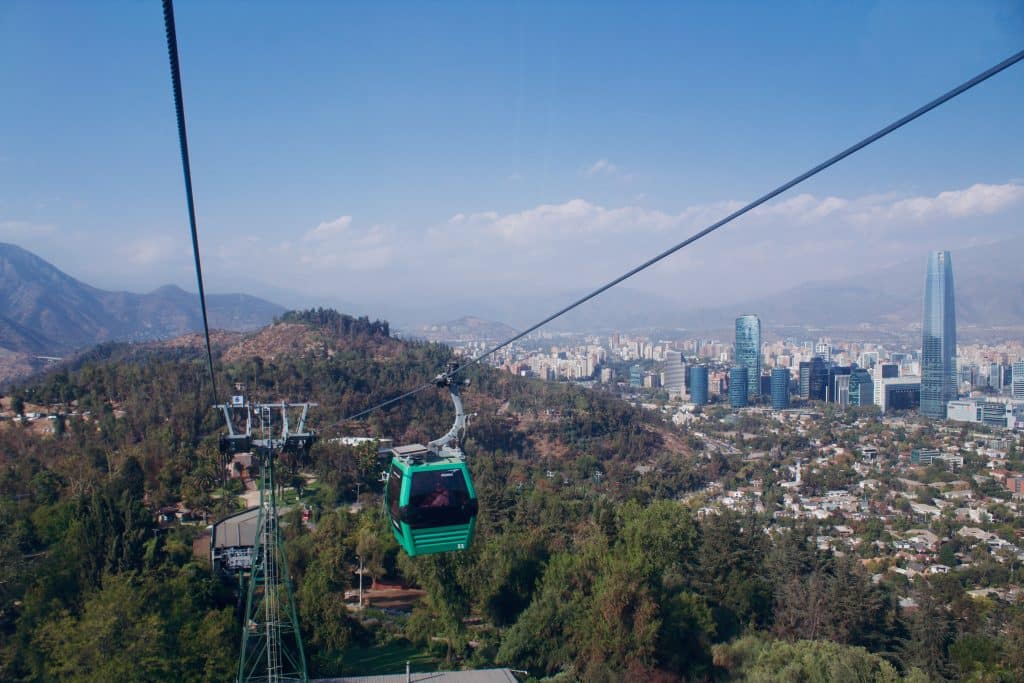
Best Things to Do in Santiago, Chile
Take the cable car to the top of Cerro San Cristóbal
San Cristóbal Hill rises from the largest park in Santiago and is one of the highest peaks. It’s a great place to shake off the jet lag and scope out the best views of the Andes!
The hill is part of the Parque Metropolitano de Santiago. There’s also a church, a swimming pool, and several botanical gardens including a Japanese garden. At the top, buy a mote con huesillos from one of the little kiosks. This is a sweet, non-boozy drink made with peaches and husked wheat.
It takes one to two hours to walk to the top of the hill. Otherwise, you can take the modern cable car (teleferico) or vintage funicular. Or you can always go up one way and return another!
The cable car leaves from Estación Oasis near the Costanera Center. It’s 10 minutes to the top and it’s a good idea to pre-book a skip-the-line ticket.
If you leave from here, I recommend stopping at La Subida for coffee and cake: the iced coffee frappes are huge and piled high with whipped cream!
The Pío Nono Funicular Station is closer to the city center. It costs 2,150 CLP ($2.30 USD) to go to the summit or you can buy a cable car/bus combo ticket for 8,450 CLP. ($9 USD). These are available in person or online.
Short on time? I’d rehoming visiting Cerro Santa Lucía instead.
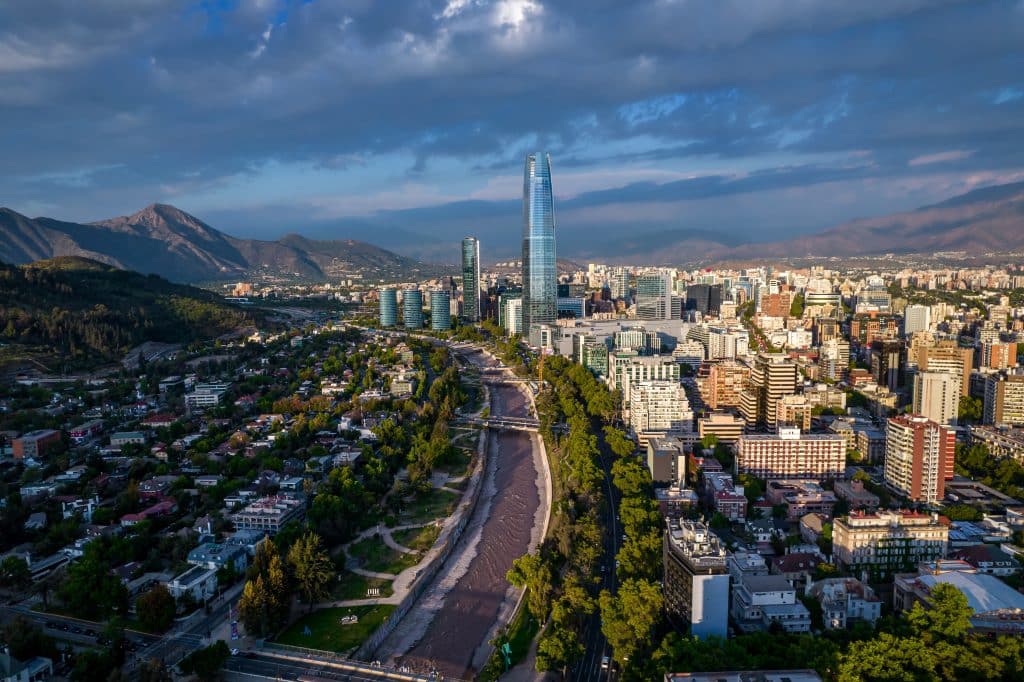
Visit the tallest building in South America
A speedy elevator delivers you to the highest point in Latin America: the Sky Costanera Viewpoint. Also known as the Gran Torre, this observation deck surveys the city and the Andes mountains. It’s attached to the Costanera Center — an enormous shopping mall.
Honestly, I think going to the top of Sky Costanera is like going to the top of the Empire State Building or the Eiffel Tower — you have a view without the icon of the city! For that reason, I think the views are superior from Cerro San Cristóbal. Though there’s something to be said for standing at the top of the tallest building in South America…
Skip the line and pre-book your Sky Costanera Observatory ticket.
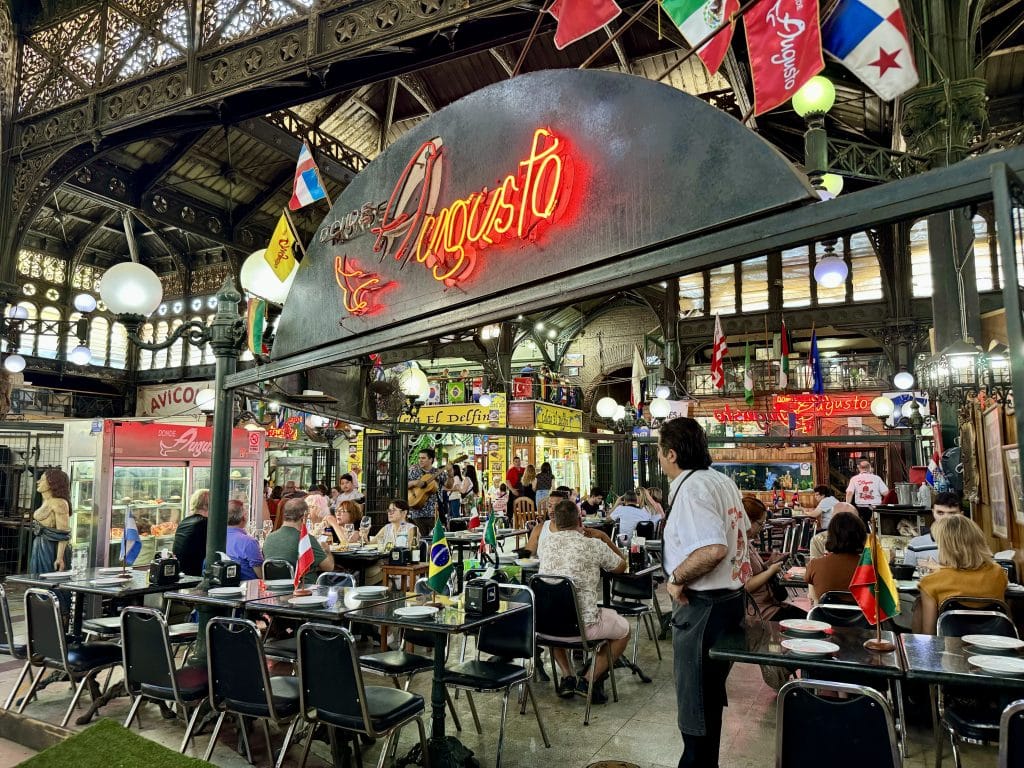
Eat at Mercado Central
Mercado Central de Santiago is an indoor market where you can browse fresh produce, food items, and flowers. It functions as a grocery market for Santiaguinos, although it’s also popular with tourists as a lunch stop, as I quickly found out.
I’ll be completely honest — Charlie and I walked in here and found the vendors so overwhelmingly pushy, we didn’t want to spend any of our time there. We left and grabbed ceviche around the corner at a wonderful restaurant called Pez de Oro that I recommend wholeheartedly!
You could instead make lunch plans at the more laid-back Mercado la Vega. It doesn’t have the wow factor architecturally, but the food is just as fresh and the vendors are more chill. Basic Spanish will help you out here, and be mindful of pickpockets at any market in Santiago.
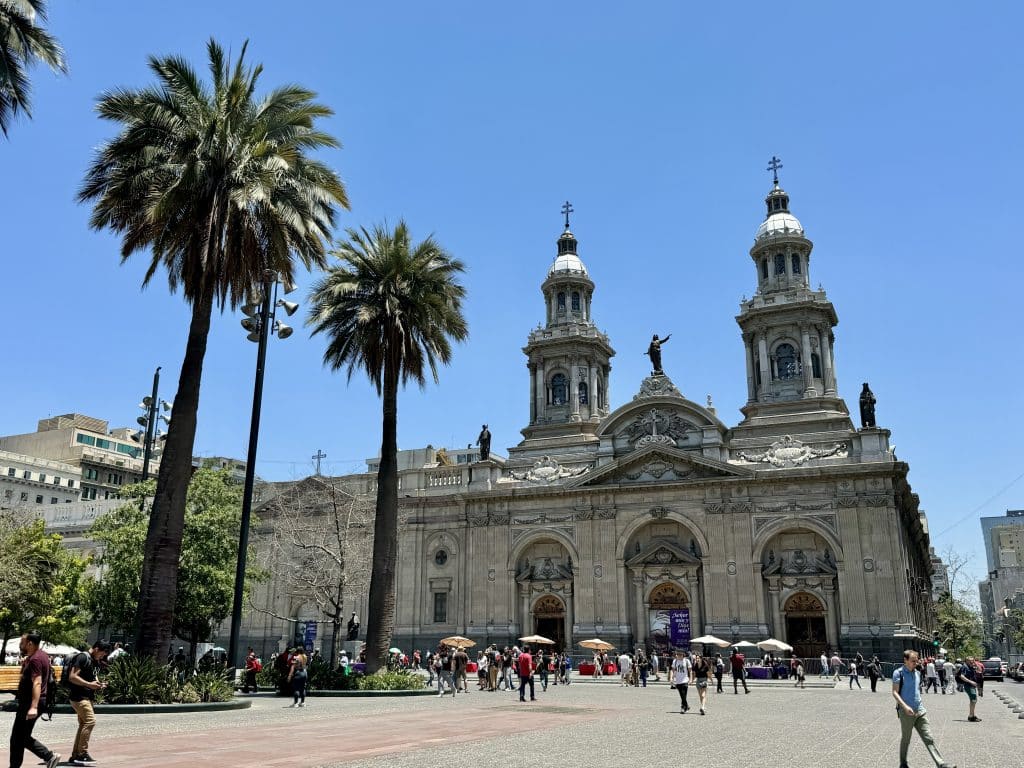
See local cultural and historical sites
Santiago lets you scratch the surface of pre and post-Columbian history while also connecting you with the progressive face of Chile.
I recommend taking a guided tour if you have time. This private Santiago three-hour walking tour hones in on such sights as Plaza de Armas and the governmental palace, Palacio de la Moneda.
This small group tour of Santiago is delivered via van and covers far more ground. Besides the places already listed, you’ll visit fun and historic neighborhoods.
Love cycling, neighborhoods and green spaces? This “Parks and Politics” bike tour includes a local bilingual guide and gear. The narration highlights recent movements in Santiago and the future of Chile.
Otherwise, you can sightsee on your own — Santiago has an efficient public transportation system of metro and bus, and Uber is available here.
Plaza de Armas — The main square marks the city center of Santiago. Note the Monument to the Indigenous People. Although intended as a tribute to the Indigenous groups who resisted the conquest, not everyone was happy with the final product.
Metropolitan Cathedral of Santiago — it’s free to pop inside this neoclassical building although be mindful of those visiting the chapels for peaceful prayer. The Central Post Office, an insanely beautiful building next door, gives the church a run for its money!
La Moneda Palace — the presidential palace played a chilling role during the military coup of 1973 and represents resilience. There’s a cultural center belowground and it backs onto the Plaza de la Constitución exhibiting statues of former presidents.
Gabriela Mistral Cultural Center — conceived in honor of the first Latin American to win the Nobel Prize for Literature, this venue celebrates visual and performance arts. It’s free to hang out inside and you can pay to see exhibitions and shows.
Bicentenario Park – a lovely spot for a stroll, a family picnic, and a possible flamingo sighting.
Quinta Normal Park – another green option west of Plaza de Armas. This is the best place for a breather between museums.
If you have more time, visiting the Templo Bahá’í de Sudamérica is one of the most unusual things to do in Santiago. It’s the “Mother Church” for the Bahá’i faith which observes the unity of beliefs. It’s quite far so I’d recommend this Bahai Temple and Cousiño Macul Vineyard tour.
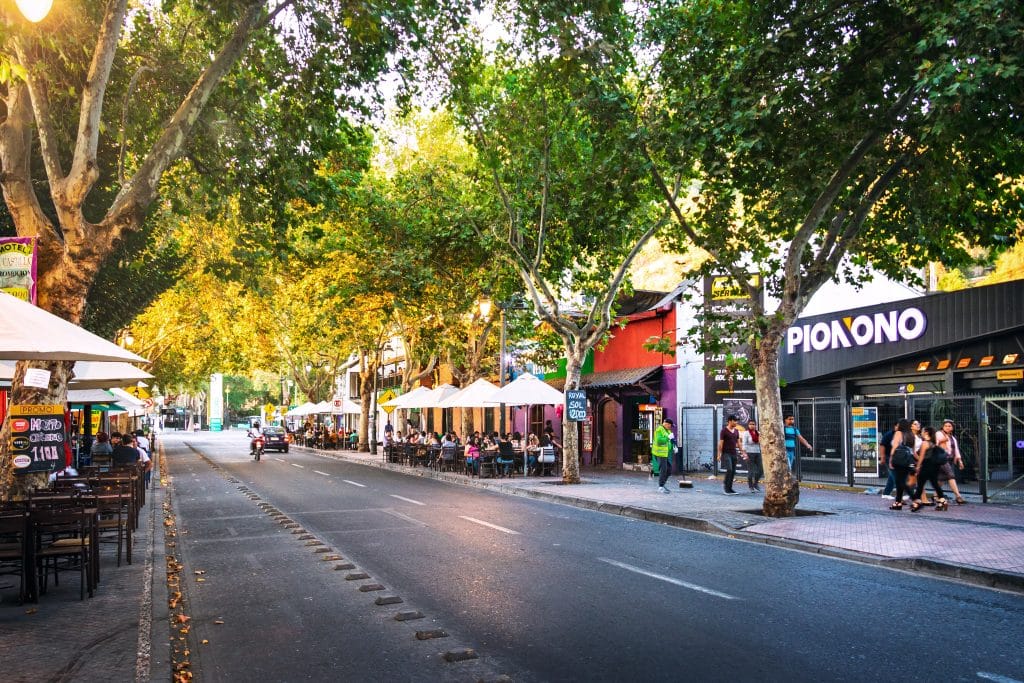
Stroll through Santiago’s coolest neighborhoods
Three of Santiago’s neighborhoods are conveniently clustered around Plaza Baquedano. At a glance, they might appear similar, but they each have a different vibe.
Barrio Bellavista is a low-slung enclave of colorful buildings housing artisanal stores, cafes, restaurants, and cocktail bars. It gets busy here from lunchtime onwards.
Lastarria nestles between Santa Lucía Hill and the Gabriela Mistral Cultural Center. Local markets and street vendors selling all kinds spring up on José Victorino and it’s a great spot for lunch and ice cream.
Barrio Italia is a fusion of Italian-Chilean restaurants, cafes, and bars. There are also places to buy antiques, handicrafts, and clothing from independent designers.
With more time on your hands, you can also visit barrios Yungay and Concha y Toro. These neighborhoods are a window into the 19th and 20th centuries. Warm up with this private walking tour to Barrio Yungay and then check out one of the nearby museums.
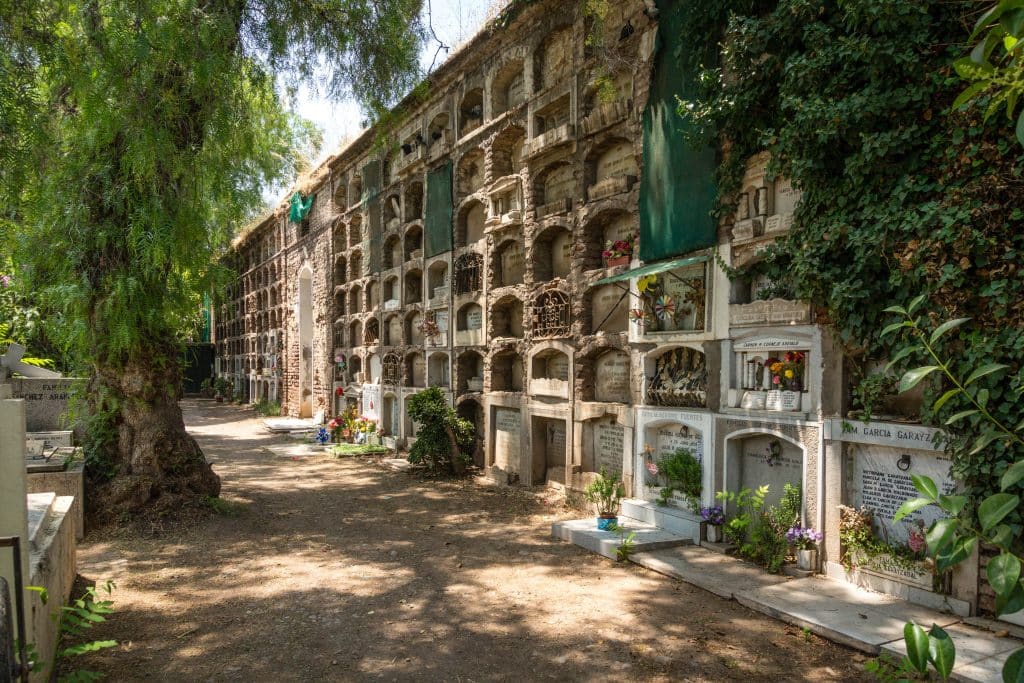
Wander through the Cemetario General de Santiago
Cementerio General dates to the early 19th century and is the resting place of prominent figures from politics and the arts. Among the grounds, you’ll find the mausoleums of President Allende and the artist Violeta Parra.
There is also a memorial in tribute to those murdered or who disappeared and were never recovered during the military dictatorship.
The ceremony is free to enter.
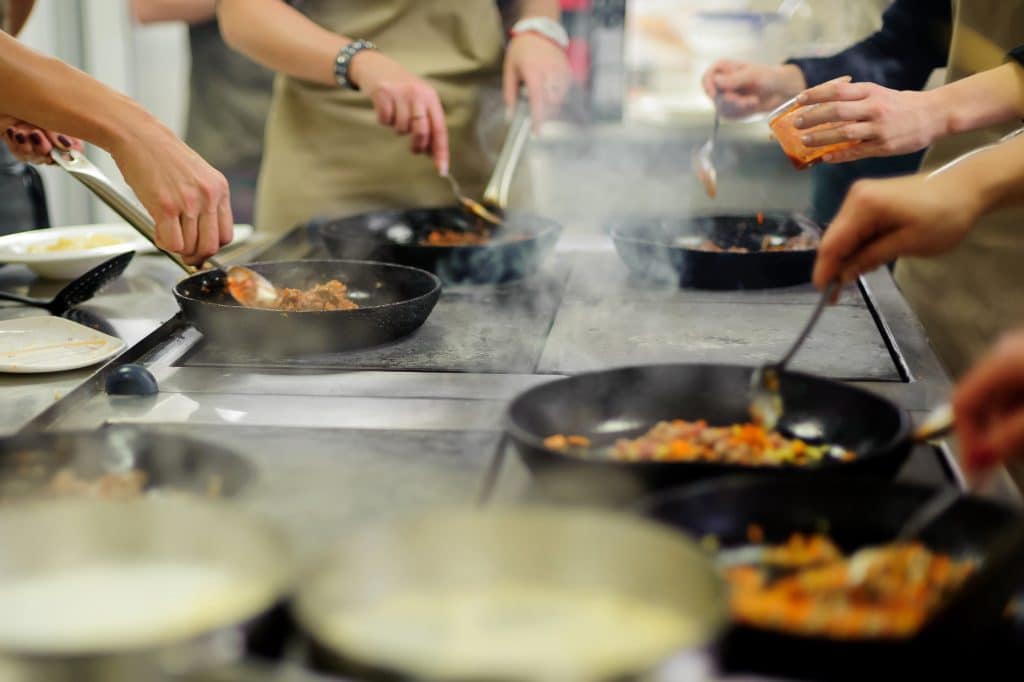
Join a Chilean cooking class
A cooking class is one of the most immersive things to do in Santiago, Chile. This traditional Chilean cooking class kicks off with a private trip to a local market where you’ll learn how to choose the freshest ingredients!
You’ll then slip into an apron at the chef’s home and cook a three-course meal from scratch. All the while, the host will explain the nuances of Chilean cuisine and talk about food culture.
Naturally, the activity concludes with sampling what you’ve made — all washed down with local Chilean wine!
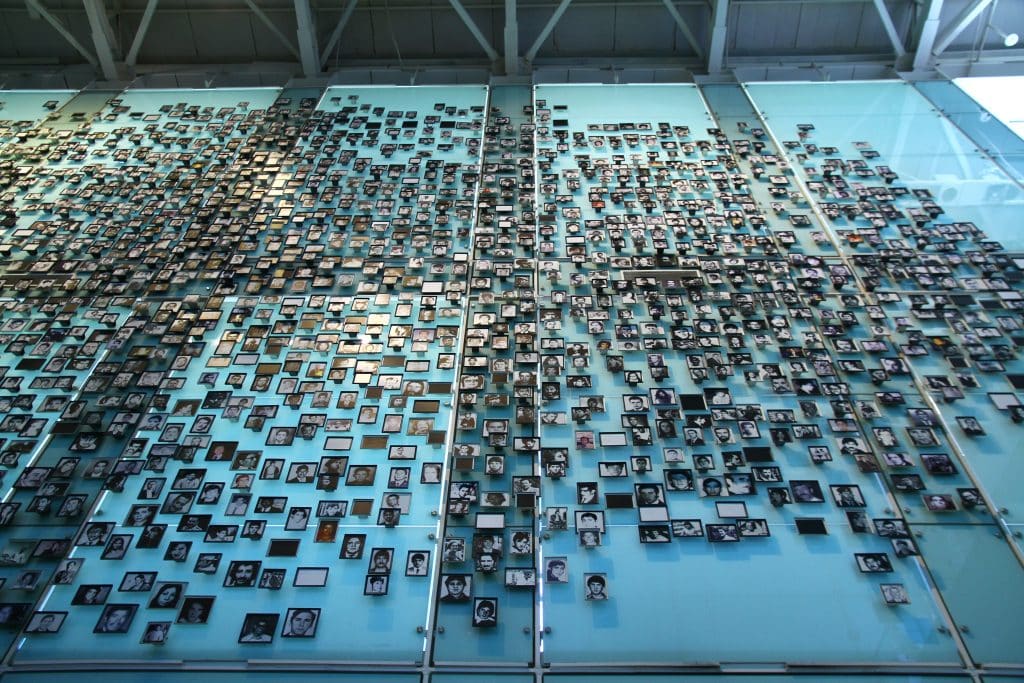
Visit Santiago’s museums
Santiago’s museum scene has you spoiled for choice! Note that all of these are closed on Mondays.
Museo de la Memoria y los Derechos (Museum of Memory and Human Rights) offers a sobering and chilling look at the military coup and dictatorship in Chile. Free to visit plus 2,000 CLP ($2 USD) for the excellent audio guide.
Museo Chileno de Arte Precolombino is the best place to learn about Indigenous art and culture in Chile and other South American nations. Admission is 10,000 CLP ($10.75 USD).
Museo Nacional de Bellas Artes (National Museum of Fine Arts) is a landmark building devoted to Chilean and international art through the ages. It’s attached to the Museum of Contemporary Art (MAC). Both are free to visit.
La Chascona is located in the Bellavista neighborhood and is one of the houses of the poet Pablo Neruda. Admission is 9,500 CLP ($10 USD).
Museo Interactivo Mirador is one of the top things to do with kids in Santiago! It also has an earthquake simulator. Admission is 7,000 CLP ($7.50 USD).
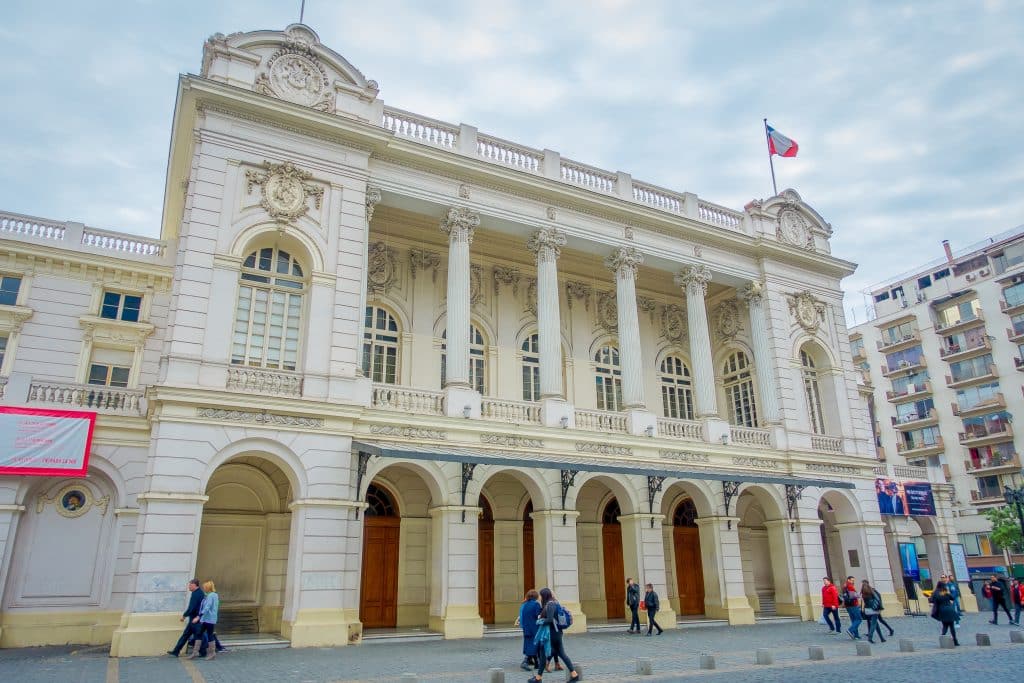
See a show at Teatro Municipal
Seeing a performance is one of the best things to do in Santiago de Chile at night. The Municipal Theater is the obvious starting place as a ticket to see a ballet or opera comes with the bonus of nosing around this lavish concert hall.
Another option is the traditional dinner show. “Voces de América” and the “Thiare” unite to put on this showcase of dances from all regions of mainland Chile, as well as Easter Island. The package includes a three-course dinner to enjoy during the show.
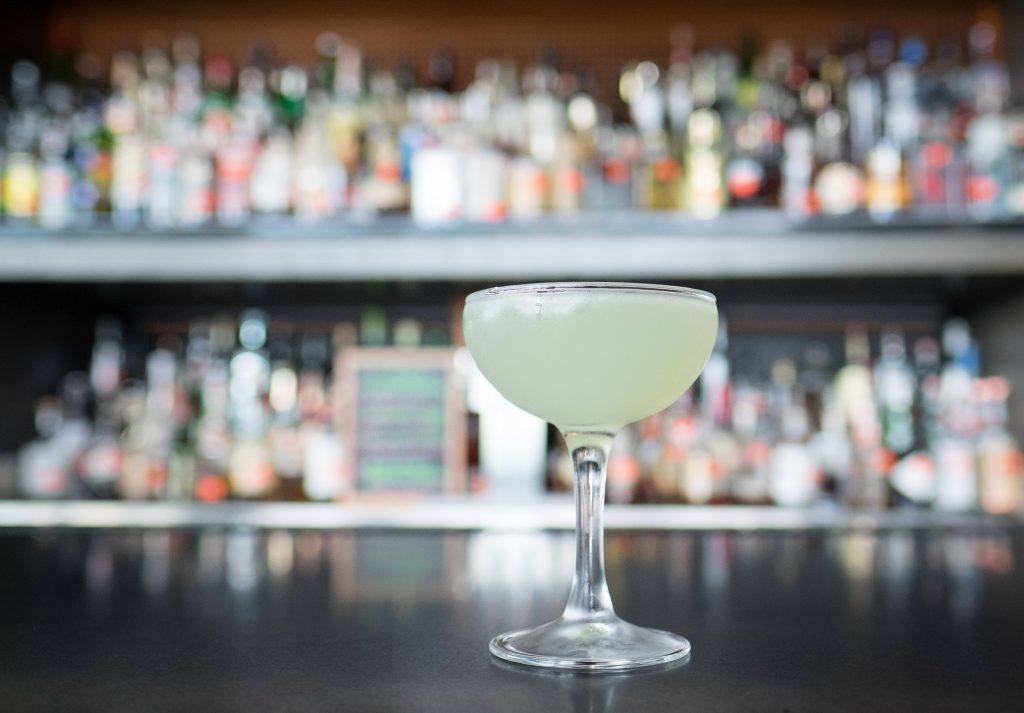
Try Pisco
Pisco, the national alcohol of Chile, is a potent spirit drunk as a lemony “Pisco Sour” or as a “Piscola” (mixed with Coca-Cola). It’s stocked in all bars and supermarkets and you can find other pisco-based cocktails on the menu besides the signature sour.
If you fancy going somewhere upmarket, the rooftop bar at The Singular Hotel has a sweet view of Cerro San Cristóbal. They stock five types of pisco and have a fun cocktail menu inspired by Chilean destinations. We enjoyed a cocktail here just before sunset!
If you want to learn a bit before having a few drinks, I’d recommend taking a pisco sour class with tastings. You’ll graduate with the knowledge of how to make four versions of the cocktail.
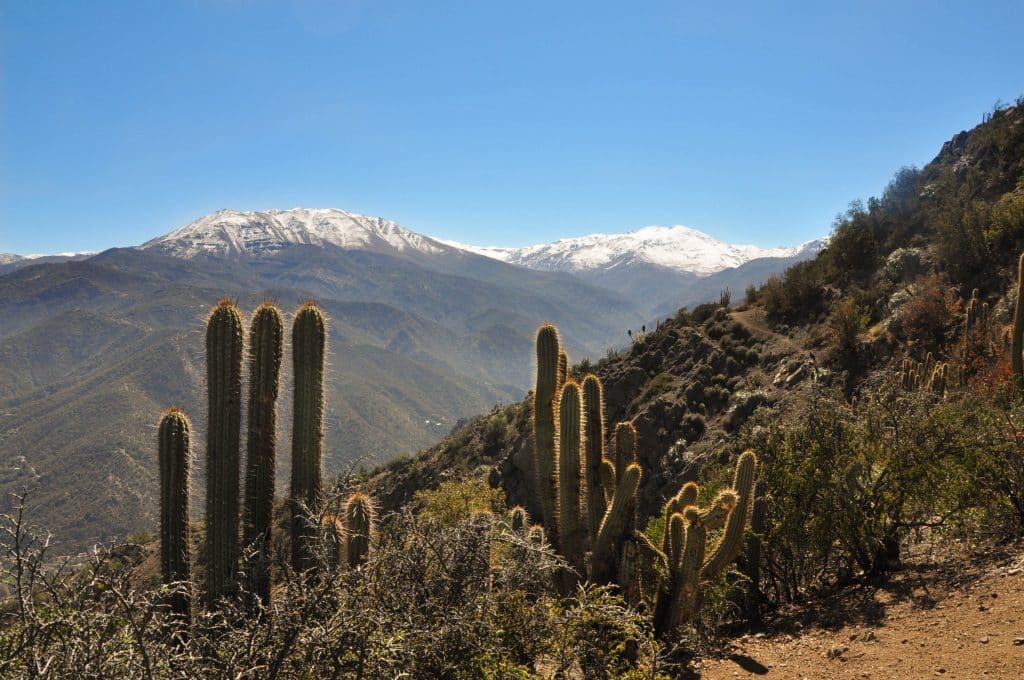
Go hiking in the surrounding mountains
If you’re spending a couple of days in Chile’s capital and the weather is on your side, do check out local hiking trails in addition to the Metropolitan Park of Santiago.
Cerro Provincia rises to the east of Las Condes. It’s a popular place to visit for hiking and spectacular views. The 11-mile summit trail requires a whole day. Ride the metro to Los Dominicos, then summon an Uber.
Shorter but steeper, it takes around three hours to ascend and descend Cerro Manquehue. It’s pretty rocky, so this one is for people who have hiking boots and poles.
Cerro Pochoco is the toughest of the trio with a lung-busting elevation gain and zero shade. For these two hikes, take the metro to Manquehue Station and grab an Uber.
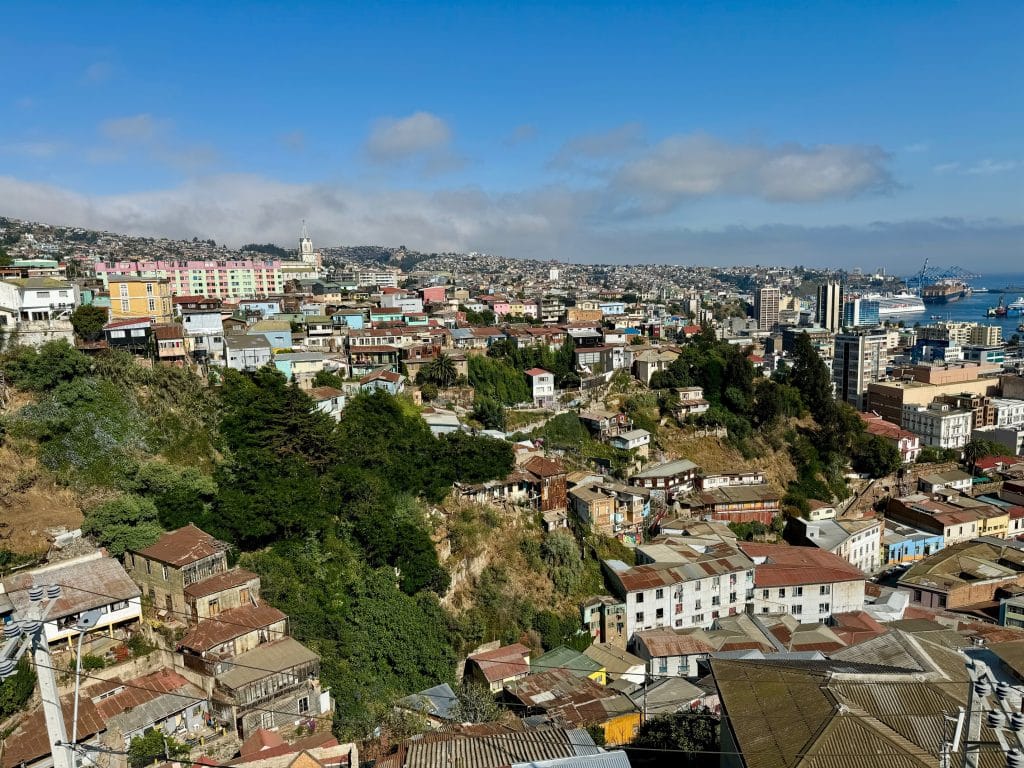
Take a day trip to Valparaíso and/or Viňa del Mar
If you are not visiting Valparaíso separately on this trip, you MUST at least go for a day trip! A UNESCO World Heritage Site, the city is built on 40+ hills and is awash with street art, galleries, local markets, and boutiques. The two hills you should aim for are Cerro Concepción and Cerro Alegre, both with gorgeous views.
If time allows, you can sunbathe on the beaches of Viña Del Mar. Swimming is off-limits due to the icy temperatures and ferocious currents – hang onto any kids!
Regular buses connect to both cities and may be booked via Turbus or FlixBus. But if you want to visit both cities in one day, I recommend booking a tour to save yourself the hassle.
This full-day tour of Valparaíso and Viña del Mar includes both cities, plus a vineyard visit on the way back to Santiago.
Another option, this Viña Del Mar and Valparaíso tour again includes a wine stop in the Casablanca Valley as well as a side trip to Reñaca. This is a posh suburb of Viña del Mar popular with local youths and the chance to spot sea lions.
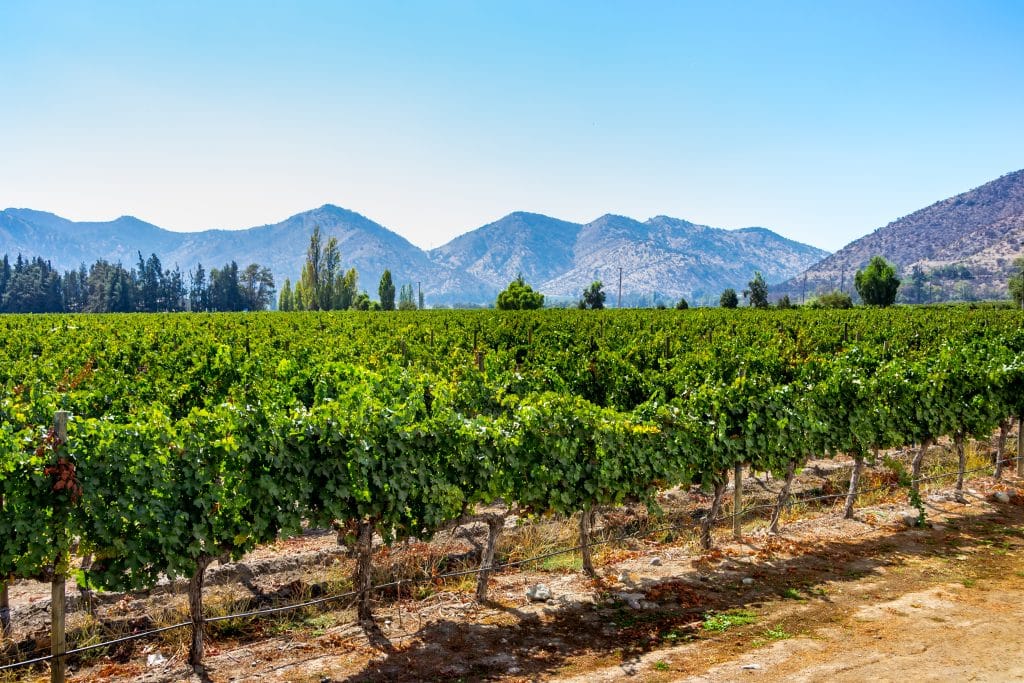
Go wine tasting in the Maipo Valley
Santiago is a great place as a base for getting acquainted with Chilean wine. The Colchagua Valley is the most popular wine area in Chile, but it’s a little too far to justify a day trip, particularly when there are so many closer options. I recommend you visit the Maipo Valley instead.
This Maipo Valley wine tasting tour takes you to three vineyards south of the city where you’ll sample fabulous Cabernet Sauvignon and Carménère reds. Lunch at a rural restaurant is an additional cost.
Alternatively, you can head west to the Casablanca Valley for whites. This valley’s proximity to the Pacific Ocean results in crisp Sauvignon Blanc and Chardonnay.
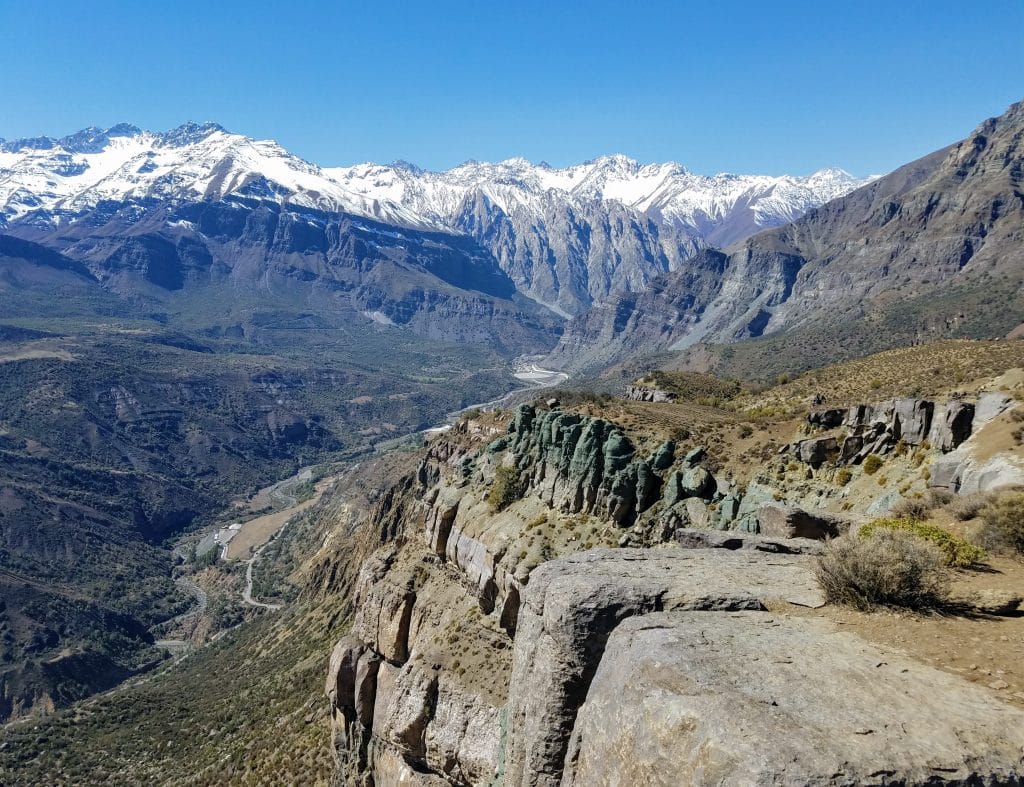
Visit the stunning Cajón del Maipo
Cajón del Maipo is one of the most spectacular areas of natural beauty near Santiago. This glacial canyon is a hub for outdoor pursuits followed by a soak in the hot springs.
This Cajón del Maipo full-day tour with rave reviews includes access to the thermal complex and a short hike to the waterfall. It concludes with a Chilean barbecue with campfire wine under the stars before heading back to Santiago in the evening.
For half the price, this Cajón del Maipo tour starts earlier and includes a light lunch. You’ll explore viewpoints around the canyon but skip the springs.
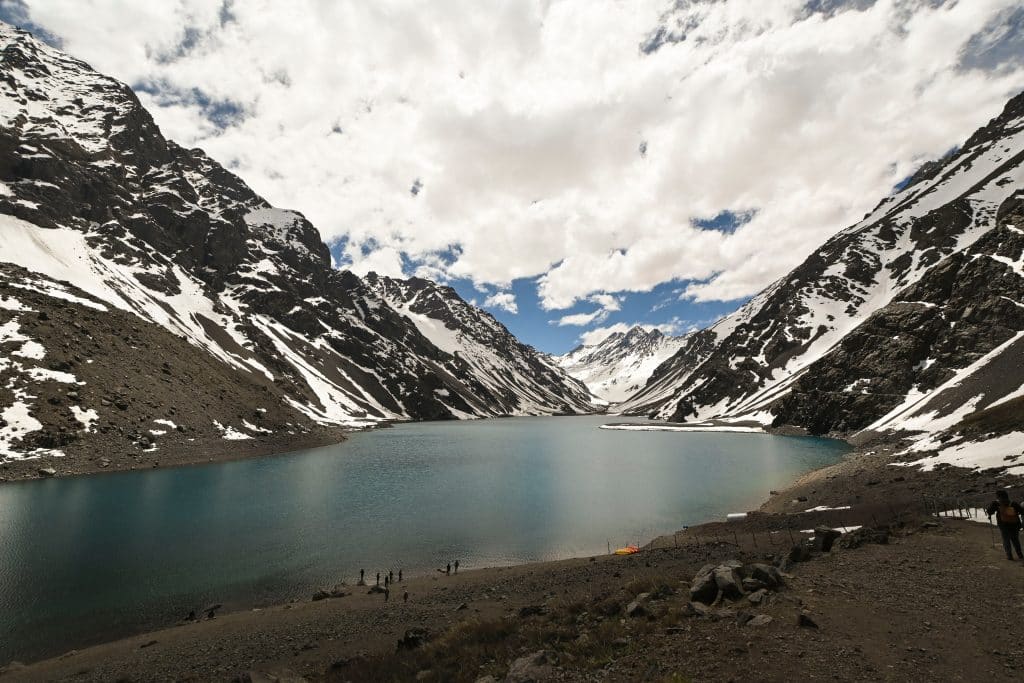
Visit Portillo Inca Lagoon
Seeing as Santiago sits at the base of the mighty Andes, you might want to seize the opportunity to get a closer look. The Laguna del Inca is at an altitude of 2,853 meters in the high mountains. Viewpoints let you take in the turquoise water and the ranges.
Getting to the lake means braving “Los Caracoles” – the snail road. These are 29 hairpin bends that ascend into the mountains near the border with Argentina.
This Andes Tour to Portillo Inca Lagoon means you can safely ogle the scenery in comfort. It also includes a stop at Viña San Esteban, where you’ll enjoy a wine tasting.
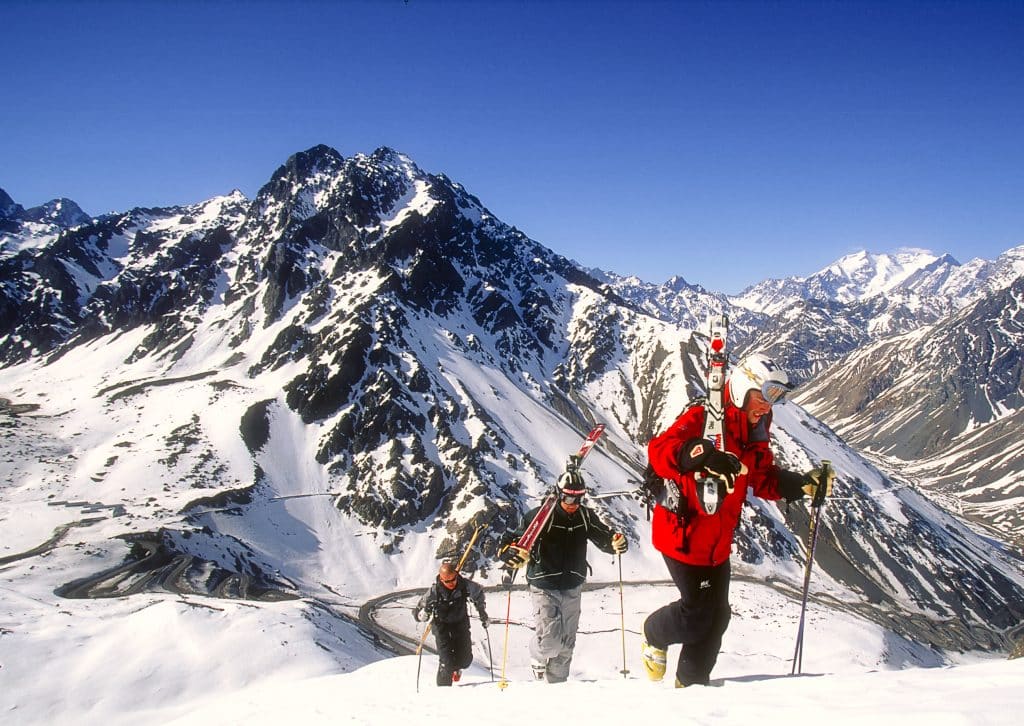
Go skiing or snowboarding
Skiing is one of the coolest things to do in Santiago in the winter! Remember, skiing season is from June to September in the southern hemisphere.
Ski Resort Portillo, near its eponymous lake, is the most famous resort near Santiago. The all-inclusive resort has ski-in/ski-out privileges and slopes for beginners and pros. You can even go heli-skiing around Aconcagua.
As part of a day trip from Santiago, the Valle Nevado ski resort is closer. This small-group tour to Valle Nevado and Farellones lets you add skiing or boarding at an additional cost.
Non-skiers can make for the mountains purely to enjoy the snowy landscape. This sunset at Valle Nevado tour includes lots of photo stops and a picnic overlooking the peaks. And a Pisco sour makes the perfect apres-ski cocktail!
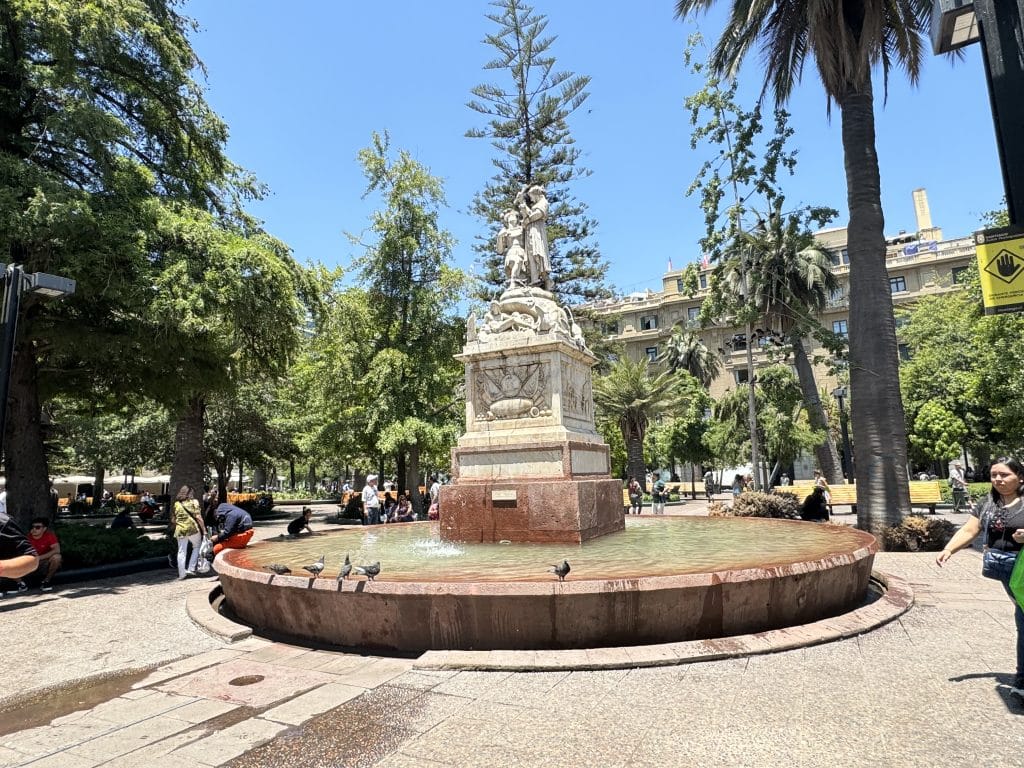
How Much Time to Spend in Santiago
I’ll be honest — most of my travel friends who have spent time in Santiago urged me to minimize my time there, and they were right. Santiago isn’t one of the most stunning destinations in Chile, nor does it have the fun factor of Buenos Aires or Mexico City or even Bogotá.
Most of the city reminded me of the Downtown Crossing neighborhood in Boston. It’s technically functional, but has been in decline for quite some time.
But if you want to experience Santiago, I don’t blame you! I would limit your time to one day in Santiago — or perhaps longer if you plan to use Santiago as a base for day trips.
If you’re looking for a base in the Central Valley of Chile, I recommend staying in the city of Valparaíso rather than Santiago. This is a much more interesting and beautiful city less than two hours by bus from Santiago.
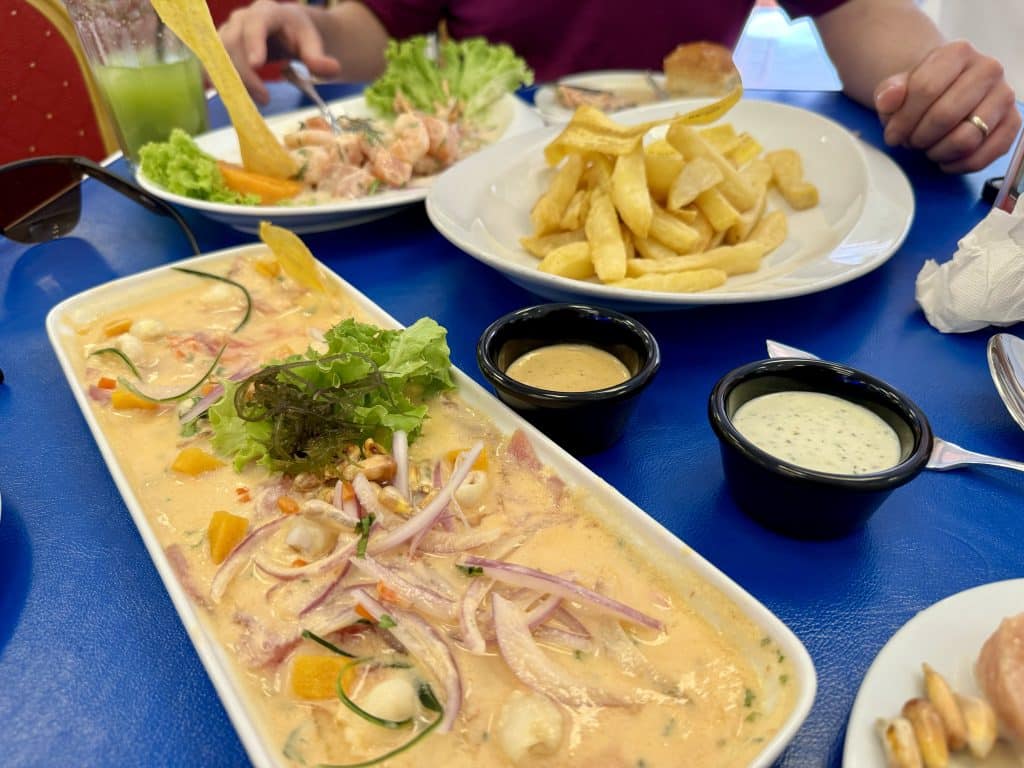
How to get to Santiago, Chile
Santiago Airport — Arturo Merino Benitez International Airport (SCL) — is located about a 20-minute drive west of the cities. It’s well-connected to major cities in American and European countries and elsewhere in Chile. I flew here direct from Amsterdam (with a refueling stop in Buenos Aires), and flew on direct to Miami.
Note that the domestic and international terminals in Santiago Airport are a 20-minute walk apart. Plus, the domestic terminal is huge and it can also take 20 minutes or so to transit between gates. This is something to think about if you’re on a quick transit from the Atacama Desert or Patagonia.
Buses depart Santiago to pretty much every city in Chile. These leave from Terminal Alameda Santiago (near the Universidad de Santiago Metro Station) and Pajaritos (at the Pajaritos Metro Station). The Recorrido website and app is user-friendly for foreigners.
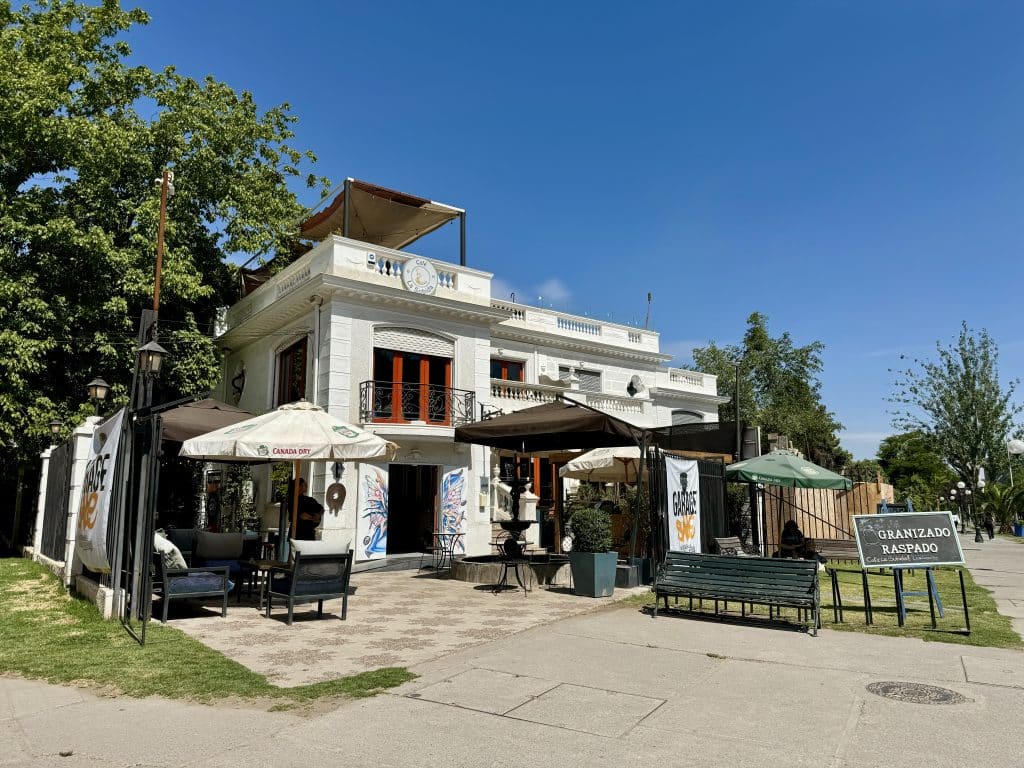
Where to Stay in Santiago, Chile
If staying centrally, choose accommodation in one of the walkable neighborhoods like Barrio Bellavista, Lastarria, or Barrio Italia. Avoid staying close to Plaza de Armas, as it’s not particularly safe at night. Providencia is the safest district in Santiago.
Luxury: Located 25 miles south of Santiago, Hotel Casa Real – Viña Santa Rita is a luxury boutique hotel on a wine estate. Rooms have sumptuous period furnishings, the restaurant is gourmet, and the grounds have a gorgeous pool.
Mid-range: Hotel Boutique Casa Conde is centrally located in Barrio Concha y Toro. Convenient for public transportation, rooms are neat and practical and the shared kitchen is a perk.
Budget: Top rooms at the BHB Hotel Boutique have a private balcony overlooking the Parque Forestal. It’s in Lastarria so only a short walk from the best places to eat in Santiago.
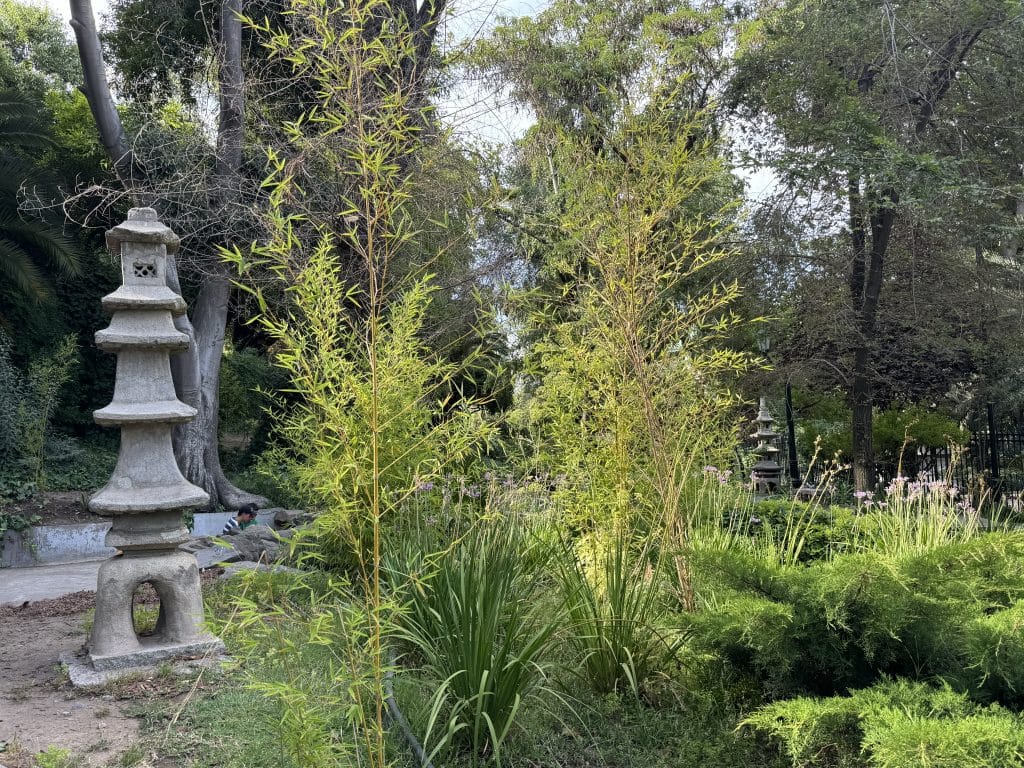
Best Time to Visit Santiago
There’s no bad time to visit Santiago: you can visit year-round. However, the shoulder season months of spring and autumn are the most comfortable in terms of weather and air quality.
The high season for international travel in South America is December through March, but this doesn’t have a major effect on Santiago in particular. Temperatures rise to the high 80s/early 90s (low 30s C) and it can get quite sticky.
Winter (June, July, and August) is frosty with lows/highs of 35 and 62 F (2 and 17 C). This is the best time to see snow coat the Andes mountains. Air quality in Santiago is notoriously poor in winter and can be risky for young children and those with respiratory conditions.
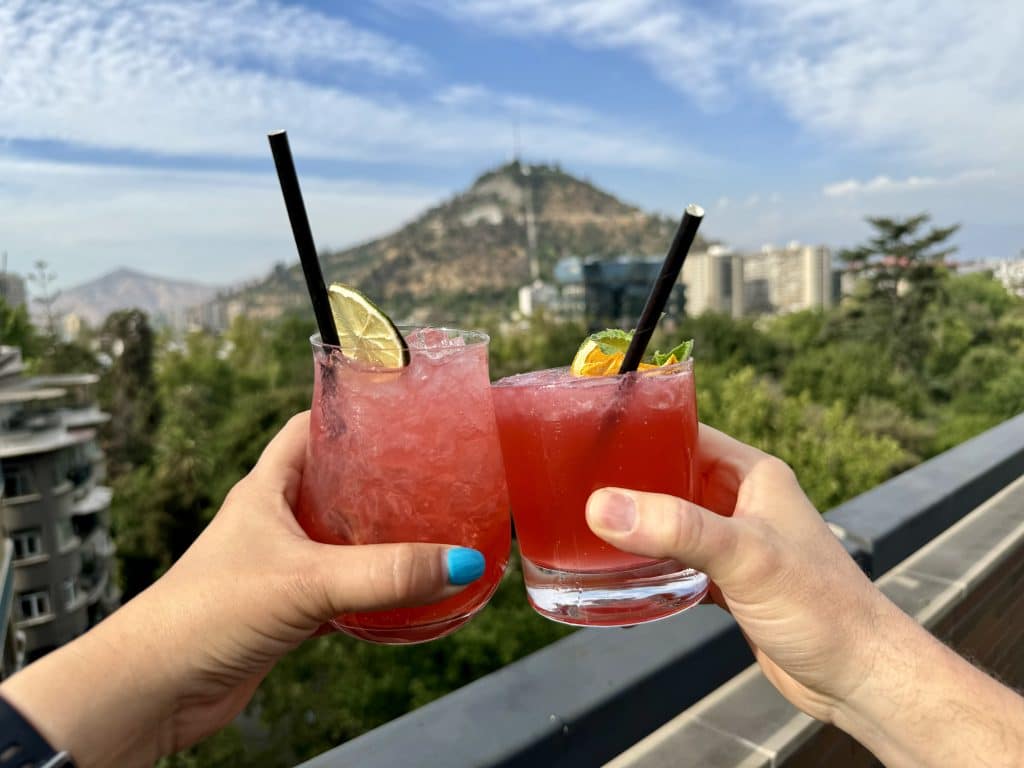
Is Santiago Worth It?
The million-dollar question. Speaking honestly, Santiago was probably the least enjoyable place Charlie and I visited on our monthlong honeymoon in Chile and Argentina.
I think you can skip Santiago and not feel bad about it at all. Want to just say you’ve visited? Then come for a half-day visit, visit Cerro San Cristóbal, walk around a bit, and have some ceviche and a Pisco sour, and you’ll probably be very happy with that.
Valparaíso is less than two hours from Santiago, and I honestly think it’s a far better place to spend a few days. More beautiful, more culture, and lots of interesting things to do. If you only have time for one place, make it Valparaíso rather than Santiago.
More on Chile:
- 26 Fun Things to Do in San Pedro de Atacama, Chile
- Staying at Ecocamp Patagonia: A Sustainable Resort in Chile
- 15 Best Things to Do in Puerto Varas, Chile
- 11 Cool Day Trips from Santiago, Chile
- 17 Colorful Things to Do in Valparaíso, Chile
More on South America:
- 32+ Fun Things to Do in Buenos Aires, Argentina
- 25 Epic Things To Do in El Calafate, Argentina
- 18 Wild Things to Do in El Chaltén, Argentina
- El Calafate vs. El Chaltén: Which Town in Argentine Patagonia is Better?
- 16 Epic Things to Do in Ushuaia, Argentina
- Solo Female Travel in Colombia: Is it safe?
- What’s it really like to travel to Guyana?
Have you been to Santiago? Have any tips to share?